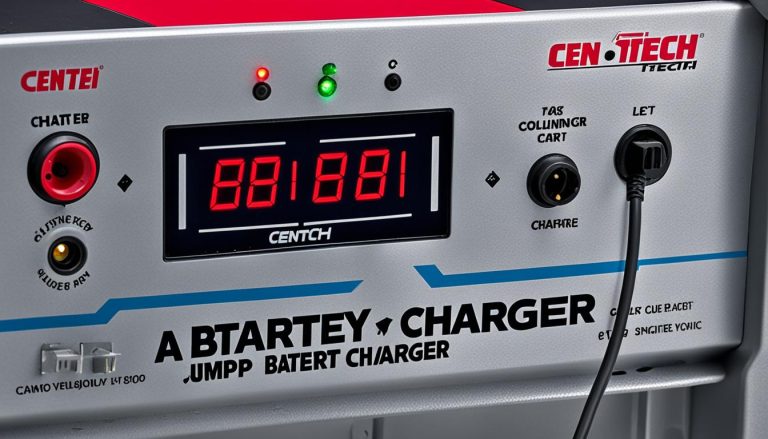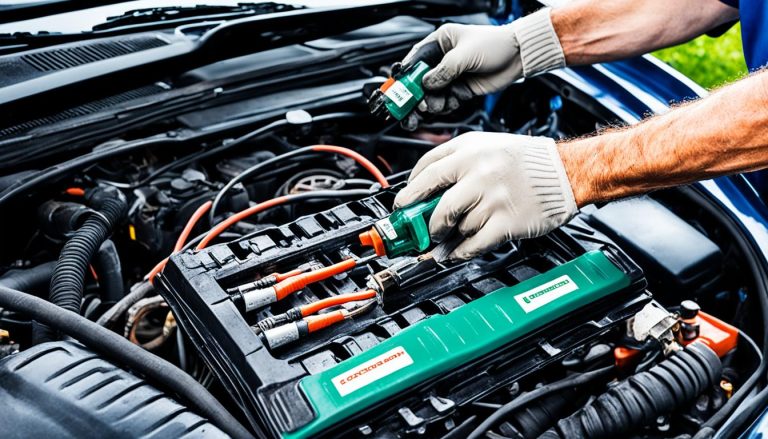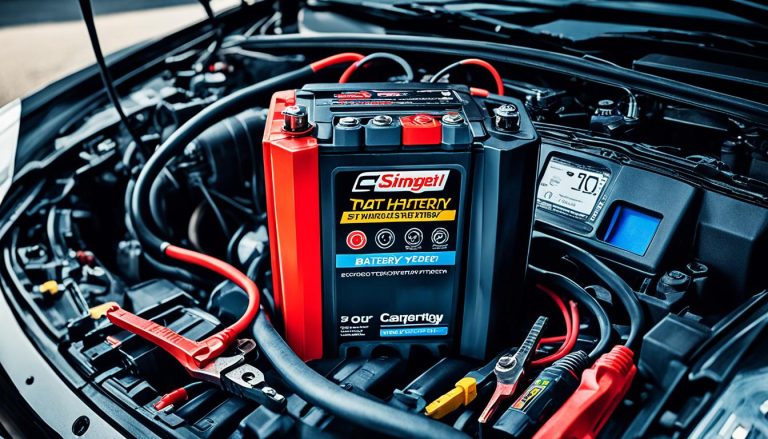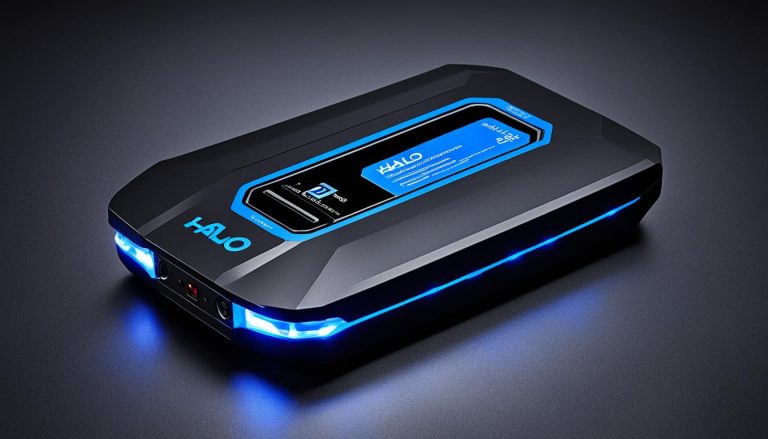How to Jump Start a Truck with 2 Batteries Easily
batterychargers.site and its partners may earn a commission if you purchase a product through one of our links
Have you ever found yourself needing to jump start a truck using 2 batteries? Whether due to cold weather, leaving your headlights on, or the unexpected happens, knowing the truck battery jump start procedure can save your day. It’s not uncommon for heavy-duty trucks, especially those with powerful diesel engines, to have two batteries. If that’s your situation, don’t worry. You’re about to learn a simple step-by-step guide for jump starting a truck with 2 batteries that’ll get you back on the road in no time.
Key Takeaways
- Understand the unique steps involved in jump starting a truck with dual batteries.
- Prepare all necessary tools and safety gear before beginning the jump start process.
- Knowledge of proper vehicle positioning can prevent short circuits during the jump start.
- Assess and ensure the donor vehicle’s battery has enough power for the job.
- Post-jump, drive for a sufficient period to allow your truck’s battery to recharge fully.
- Following safety procedures ensures a successful and hazard-free jump start.
Understanding the Need for Dual Batteries in Diesel Trucks
If you’ve peeked under the hood of a diesel truck, you may have noticed something that stands out from its gasoline counterparts – a diesel truck with two batteries. Have you ever wondered why? The answer lies in the nature of diesel engines themselves and the challenging demands they face during operation. Let’s delve into why your diesel truck is equipped to be a dual battery powerhouse.
Diesel engines are known for their enduring strength, but that strength comes with higher compression ratios compared to gasoline engines. To get that powerful engine turning over, especially in cold weather or under heavy loads, it requires a formidable burst of power. Hence, two batteries are used in tandem to provide the necessary cranking amps – a setup you might refer to as a dual battery jump start for trucks.
These two batteries do more than just help the engine start. Think about the high resistance loads in diesel engines that come into play – everything from the ignition systems to the heavy-duty injectors, and the myriad of electrical components that all need to work synchronously. With a dual battery configuration, the load is effectively distributed, ensuring that these components receive the reliable energy needed to perform optimally.
When you’re confronted with the need to jump start a diesel truck with two batteries, remember the importance of adhering to proper procedures. Incorrect jump-starting methods can lead to damage, not just to the batteries, but to the electrical systems they support.
Understanding the intricate details of your diesel truck’s dual battery setup is not just about having technical know-how; it’s crucial for safe and efficient vehicle maintenance. Whether it’s through routine check-ups or the dire need for a jump start, knowing the role of those two batteries can save you from a headache down the road. Always ensure that the health of your diesel truck’s two-battery system is at its best, fostering a robust and responsive drive time after time.
Showcasing the Different Indicators of a Dying Battery
If you’ve ever faced the dreaded click or slow turnover of your diesel engine, you know the importance of a healthy battery. Recognizing the signs of a weak battery can mean the difference between a standard morning and a day disrupted by automotive issues. As such, it is valuable to understand the tell-tale signs that your truck might soon require a diesel battery jump starter or even a battery replacement.

When discussing the vitality of your truck’s starting system, the scenario in which you would need to jump start a truck with two batteries is not ideal but common. Dual batteries for diesel engines are not just about having a backup; they provide the necessary amperage for a stronger, more energy-intensive crank. But when these power sources wane, you’ll notice several cues that must not be ignored.
Slow Engine Cranking as a Warning Sign
One of the most immediate signs of potential battery failure is a slow cranking engine. This manifests as a sluggish or prolonged turnover when you turn the ignition key. It’s the battery’s cry for help, signaling that it might not be able to perform its primary duty much longer and that it may be time to replace the diesel truck battery.
Observing Dashboard Anomalies and Slow Engine Performance
The dashboard can serve as an early warning system – a battery’s own check engine light, if you will. Be watchful for erratic behavior of the lights or gauges; these irregularities can be precursors to a non-responsive state during ignition attempts. Alongside this, if engine performance seems to drag alongside electrical inconsistencies, it’s time to assess your batteries.
- Fading dashboard lights or unusual dimming
- Electrical components not operating at full capacity
- Unexpected system indicators lighting up
While these symptoms can indicate other issues, they are often associated with a weakening battery. Stay alert and proactive. Should you encounter these, consider testing your truck’s battery and preparing for action – whether that’s a jump start or a trip to your mechanic for a potential battery replacement.
Pre-Jump Preparation: Ensuring Safety and Efficiency
When you’re about to jump start a truck with dual batteries, it’s not just the cables you need to be mindful of; it’s also the overall safety and readiness of the equipment and vehicles involved. So, let’s sharpen our focus on the proper jump start preparation to secure a safe and successful jump-start. Here’s what you need to take into account:
- Verify the health of the donor vehicle’s battery, ensuring that it has enough juice to support the jump-start process.
- Inspect your jumper cables and clamps for any signs of wear or damage.
- Ensure that both vehicles are off with all electronics disabled to avoid electrical spikes or damage.
- Position the donor vehicle close to your truck, but not so close that the vehicles touch, which could lead to potential shorting.
It is also crucial to match the voltage of the donor battery to the needs of your truck to prevent any complications. Here’s a quick reference guide:
| Truck Requirement | Donor Battery Status |
|---|---|
| 12-Volt System | Fully Charged, Robust Condition |
| 24-Volt System | Dual Battery or Equivalent Power Source |
Remember, jumping a truck with a dual battery setup isn’t an everyday task. If you have any hesitations, it might be best to call a professional. Safety always comes first, and a proper setup is key to avoiding any undesirable situations.
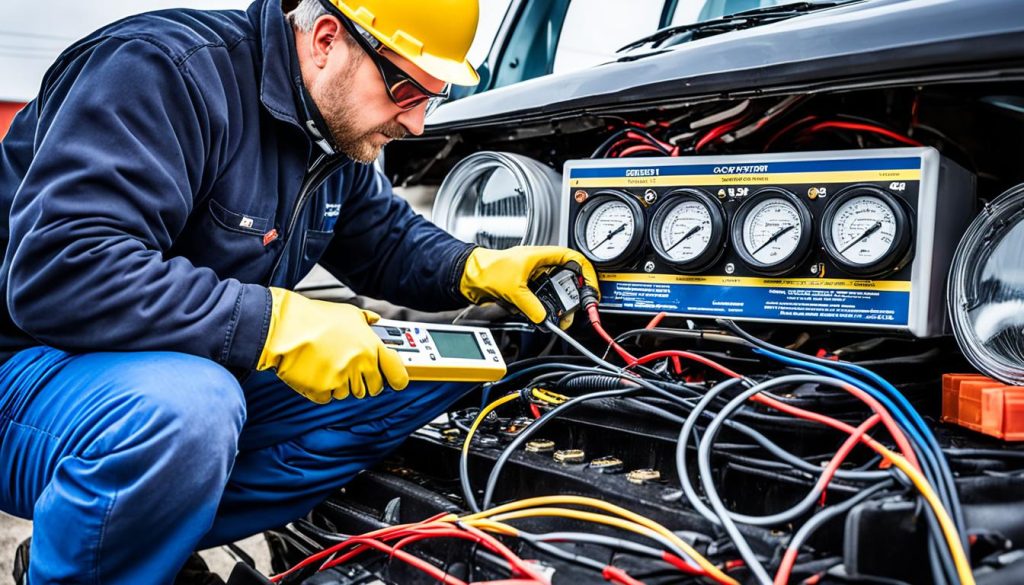
“Before attempting to jump start your truck, always consult your vehicle’s manual for any specific instructions or safety warnings related to your model.” – Professional Mechanic Tips
Jump Start a Truck with 2 Batteries: A Step-By-Step Guide
Successfully performing a dual battery jump start for trucks requires careful planning and implementation. This guide aims to help you navigate the process of jump starting a truck with two power sources efficiently and safely. By understanding the proper vehicle positioning for jump start, the methodology of connecting jumper cables, and the importance of an efficient truck battery jump start procedure, you’re less likely to encounter complications during this emergency fix. Let’s get started.
Selecting the Right Tools and Safety Gear
To ensure a secure and effective jump start, the right equipment is vital. Equip yourself with heavy-duty jumper cables that are long enough to easily span the distance between the donor vehicle and your truck. Safety is paramount, so wearing insulated gloves and safety glasses will protect you from potential electrical hazards. Here’s what you should have ready:
- Quality jumper cables with sufficient length and gauge
- Protective gloves and safety glasses
- A functional and fully-charged donor battery source
Vehicle Positioning and Cable Management for Successful Jumping
The correct positioning of the involved vehicles is crucial. Both the donor vehicle and your truck should be parked, ensuring there’s ample room to work safely while preventing any physical contact that could lead to a short circuit. Once positioned, it’s time to lay out your jumper cables.
- Connect the red clamp to the positive (+) terminal of your truck’s first battery.
- Attach the other red clamp to the positive (+) terminal of the donor vehicle’s battery.
- Secure the black clamp to the negative (-) terminal of the donor battery.
- Fasten the final black clamp to an unpainted metal surface on your truck’s engine block to serve as a ground.
After the truck starts, the disconnection procedure should be handled in reverse, starting with the negative clamps. A detailed demonstration is outlined in the following table:
| Connection Order | Positive (+) Lead | Negative (-) Lead |
|---|---|---|
| 1. First Connection | Truck’s 1st Battery | – |
| 2. Second Connection | Donor Vehicle’s Battery | – |
| 3. Third Connection | – | Donor Vehicle’s Battery |
| 4. Ground Connection | – | Truck’s Engine Block |
It’s essential to remove the cables in the exact opposite sequence after the jump start is complete. Follow up with a short drive, at least 15-20 minutes, to allow the truck’s alternator to charge the battery adequately. Proper procedure will help ensure that your next start is trouble-free.
Post-Jump Start: Important Procedures to Follow
Picture this: you’ve just given your truck a successful jump start. A sigh of relief! But your job isn’t done yet. What comes next is crucial for charging a truck battery post jump start and maintaining truck battery life post jump. It’s now time to ensure the battery gains enough charge to keep you moving without hiccups.
Here’s a friendly reminder: After the revival of your truck’s heartbeat, make it a point to take a continuous drive for at least 20 minutes. This period of uninterrupted driving is key as it aids your alternator in replenishing the battery’s charge. Why does this matter? Simply put, without this essential step, your battery may not have the stamina for your truck’s next ignition sequence.

While driving, your alternator does the heavy lifting – it’s the steadfast warrior that battles battery drainage by ensuring a consistent recharge. However, sometimes circumstances might not permit an immediate long drive. If this is the case, consider employing a battery charger as a temporary ally in the quest to maximize your battery’s lifespan.
- Inspect battery connections for tightness and corrosion-free terminals
- Monitor your battery’s charge level with a voltmeter
- If possible, avoid short drives that prevent a full charge cycle
By being attentive to these pointers, you’re not just preparing for the next start-up but also investing in the longevity of your truck’s battery. Take charge of your post-jump routine, and ensure that your battery stays robust, ready to sustain the fires of ignition, and willing to power your journeys ahead.
Jump Start Safety Do’s and Don’ts
When it comes to preserving the life of your truck’s battery and ensuring a smooth start, the safe truck jump starting process cannot be overstated. Below, we will navigate through the essential best practices and specific common errors to avoid for a successful truck battery jump start.
Effective and Safe Jump Starting Practices
Adhering to the following precautions during truck battery jump start will safeguard you and your vehicle:
- Before initiating a jump start, ensure both vehicles are turned off, set to park or neutral, and the emergency brakes are engaged.
- Inspect the battery terminals and clean any corrosion with a wire brush, ensuring a clear passage for power.
- Wear protective eyewear and gloves if available to mitigate the risks from possible sparks or acid.
- Turn on the heater of the disabled truck beforehand to absorb any excess voltage and protect the electrical system.

Common Mistakes to Avoid During the Jump Start Process
Making sure to avoid these common truck jump start errors is as integral as following the right steps:
- Avoid smoking or open flames around the battery area as batteries emit flammable hydrogen gas.
- Never attempt to jump start if the battery is visibly damaged, leaking, or frozen. These could lead to dangerous explosions.
- Be cautious to never let the ends of the jumper cables touch, as this could cause a short circuit.
- Always confirm the voltage of the donor battery aligns with your truck’s battery to prevent overloading electrical systems.
In addition to these safety measures and error prevention tips, it’s crucial to continue adhering to jump start procedure best practices even after your truck is up and running. The following table highlights further critical steps to take post jump start.
| After Jump Starting Your Truck | Why It’s Important |
|---|---|
| Drive the truck for at least 20 minutes | Helps to recharge the battery and ensures it has sufficient voltage for future starts |
| Check electrical systems and lights | Confirms all systems are functioning properly after the voltage surge |
| Consider a battery test | Determines battery health and if it can hold charge for peace of mind |
By meticulously following these guidelines, you not only ensure a safer jump start process, but also contribute to the longevity and reliability of your truck’s battery. Always remember, safety comes first and taking the right precautions can prevent costly mishaps and potential accidents.
Addressing Common Concerns and Troubleshooting
When you’re faced with the task of troubleshooting a truck jump start, it’s crucial to recognize that even with careful preparation, hiccups can occur. Perhaps your truck didn’t roar to life on the first try, or maybe it’s displaying erratic power behavior post jump. These instances can certainly evoke concern, but they often have straightforward solutions. The initial step in addressing any truck jump start concerns should always be to double-check your cable connections. Loose or incorrect cable connections are common culprits and can prevent the necessary voltage from reaching your truck’s starter.
It’s also paramount to ensure that the donor vehicle’s battery is fully charged; a lack of sufficient power can result in an unsuccessful jump start. If the donor vehicle has a healthy battery and your connections are secure but your truck still struggles to start, it’s time to inspect your truck’s batteries for potential damage. Look for any telltale signs like corrosion, leaks, or bulging, which can impact performance and may even be dangerous.
Understanding the nuances of addressing truck jump start concerns is key to navigating these situations effectively. Be mindful of the battery’s voltage and condition, and don’t hesitate to seek a professional evaluation if you’re unsure of the issue. By keeping a careful eye on the details and conducting a thorough review process, you can confidently overcome these hurdles and get back on the road with minimal fuss.
FAQ
What is the step-by-step guide for jump starting a truck with 2 batteries?
The step-by-step guide involves positioning the donor vehicle close to the truck with dual batteries, connecting the jumper cables in the correct order—positive to positive first, then negative to an unpainted metal surface on the truck with the dead batteries. Once connected, start the donor vehicle, run it for a few minutes, then try starting the truck with dual batteries. If the engine starts, let it run to charge up before disconnecting the cables in reverse order.
Why do diesel trucks have two batteries?
Diesel trucks often come with two batteries to provide the necessary power for cranking the engine, which has higher compression than gasoline engines. This setup ensures enough power for high resistance loads at startup and reliable functioning of the vehicle’s electrical components.
What are the signs that a truck’s battery may be weakening?
Signs of a weakening truck battery include slow engine cranking, unusual noises like clicking when the key is turned, dashboard light flickering, and overall sluggish engine performance. These indicators suggest that the battery might need replacing or charging.
How should I prepare to jump start a truck with dual batteries?
Before jump starting, make sure both trucks are turned off, set the parking brakes, and put on safety gear like gloves and safety glasses. Use quality jumper cables and ensure there’s no contact between the metal clamps to prevent shorting.
How do I ensure a successful jump start with dual batteries?
For a successful jump start, use heavy-duty jumper cables and ensure proper connection to the battery terminals and a good ground on the engine or frame. Follow the correct sequence for connecting and disconnecting cables, and ensure the donor vehicle has a sufficiently charged battery to provide the necessary power.
What should I do after successfully jump starting a truck with 2 batteries?
After jumping the truck, keep the engine running for about 20 minutes without using accessories, to allow the alternator to recharge the battery. It’s also advisable to have the battery and charging system checked by a professional.
What are some safe jump starting practices I should follow?
Always use sturdy, well-insulated cables, wear safety gear, and turn off all electrical loads before connecting the jumper cables. Be sure that both vehicles are in park or neutral position with their ignitions switched off. After jump starting, remove the cables in the reverse order of how you connected them.
What are the common mistakes to avoid when jump starting a truck with 2 batteries?
Do not smoke near the batteries, try to jump start a frozen battery, or jump start a battery that is leaking or has visible damage. Ensure the cables do not touch each other or the two vehicles do not touch, which can cause short circuits or damage.
How do I troubleshoot issues if the truck doesn’t start after the jump?
Check to ensure all connections are secure and correct, and that the jumper cables are not faulty. Make sure the donor vehicle has a battery with enough voltage. If issues persist, the truck’s batteries might be too depleted or damaged and may need professional assessment.

